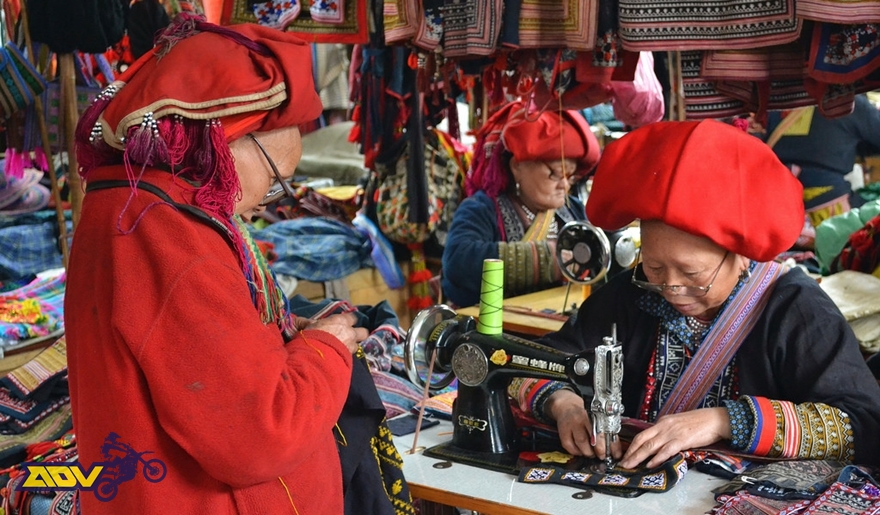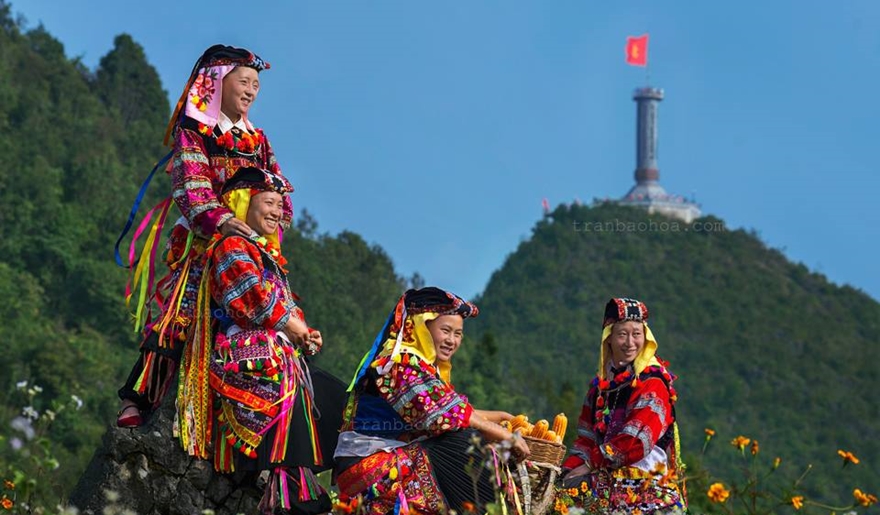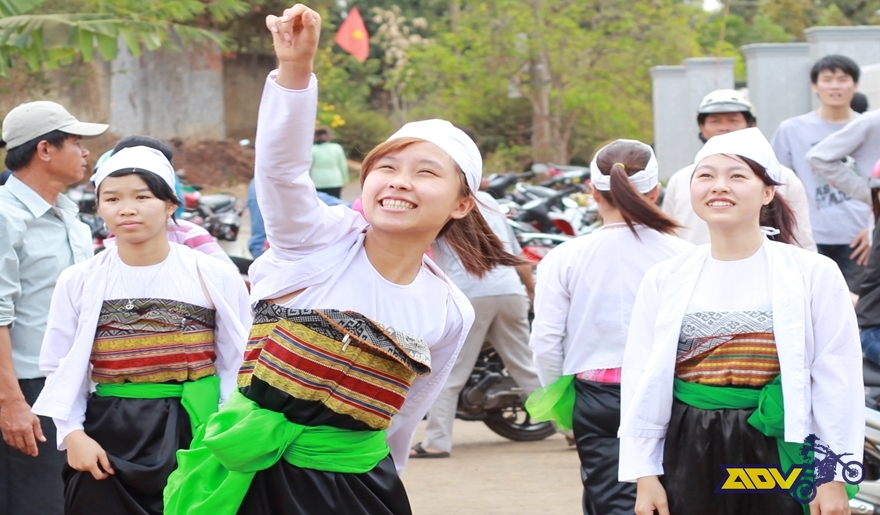Main Features of the Ethnic Minority Groups in the North of Vietnam
23-11-2017 3418 view
Main Features of the Ethnic Minority Groups in the North of Vietnam
In our Vietnam motorbike tours, besides enjoying the journey on two wheels rider will be stayed in the wilderness to experience the local culture. In those places, we will stay with local, eat the food they cook, drink the water they boil, sleep on their bed. Therefore, we recognize the need to provide basic information about the customs and practices of ethnic minority people who we stay or meet on the road for you to learn before coming. This will help rider to avoid cultural shocks which could make the trip not as great as desired.
The Socialist Republic of Vietnam has 54 different ethnic groups. Of which, the Kinh (Viet) accounts for nearly 90% of the total population, more than 10% is the population of 53 ethnic groups.
Over the centuries, the Vietnamese community has been attached to each other throughout the history of fighting against invaders, protecting the border, gaining freedom and independence, and building the country. Each ethnic group has its own spoken language, written language and cultural identity.

The Hmong People
Name of the group: The Hmong group is one of the 54 ethnic groups in Vietnam. In China they are called Miao and this name is used in the international literature that is Miao, as in English is Miao people. The Hmong use a variety of self-name such as Ghao Xong, Hmu, Hmao, Hmong. The term “Hmong” is proposed as the name of the groups Miao speaking Hmong dialects in China and Hmong people living outside China.
Total population: According to the Census of population and housing in 2009, the Hmong has a population of 1.068.189 people and they ranked 8th in the list of the ethnic groups in Vietnam.
Locality: The Hmong ethnic group usually reside between 800 and 1500m above sea level, including most of the Northern moutainous provinces in a relatively large area, along the Vietnam-China borer and Vietnam-Laos border from Lang Son to Nghe An, mainly in the provinces of the East and Northwest of Vietnam such as Ha Giang, Lao Cai, Lai Chau, Son La... Due to nomadic habits, some Hmong people in the 1980s, 1990s migrated to the Central highlands, scattered in parts of Gia Lai and Kon Tum.
Language: The Hmong speak Hmong’s language. This is mainly language in the Hmong-Mien language. The Hmong language has not written. Now commonly is used that is the Latin Hmong (RPA) and established in 1953.
Traditional customs: The Hmong people have a very strange custom. That is procedures for “wife stealing”. According to the “wife stealing” custom, after three days of capturing his wife, the men had to accompany his parents to bring gifts including pork, chicken and wine to the girl’s house for giving thanks and for marriage agreed to two people get married. Today this procedures is somewhat different progress, in Vietnam, the change is similar the Kinh people. The girls are freedom when they choose mate. Food culture of Hmong people is very rich and diverse.
Costume: The traditional Hmong women’s dress consists of skirts, chest-skirt, back bras, a front cover and a small square back over, a waistband, a headband and leggings. The skirt is conical, folded with many folds. Beside, The Hmong people have jewelry such as earrings, necklace, bracelet, bronze, silver ring, gold ring...
Economy: The Hmong mainly cultivate and raise livestock and poultry.

The Dao People
Name of the group: The Dao group is one of the 54 ethnic groups in Vietnam. They also have other names such as Man, Dong, Trai, Diu Mien, Kim Mien...
Total population: According to the Census of population and housing in 2009, the Dao has a population of 751.067 people.
Locality: In Vietnam, although the Dao people have not a large population, their villages are settled in the Northern moutainous area (Cao Bang, Ha Giang, Lao Cai, Yen Bai, Lai Chau, Tuyen Quang...) to some midland provinces such as Phu Tho, Vinh Phuc, Hoa Binh and Quang Ninh.
Language: The Dao has writing in China characters (Dao Nôm script).
There are several distinct groups within the Dao ethnic group and these groups also speak in several languages from different linguists.
Traditional customs: They worship ancestor that is Ban Ho. It is possible to determine the family line and hierarchy of the Dao through the middle name. The funeral of the Dao is made according to ancient custom. They have many folk song, poetry and stories.
Costume: In traditional attire, the men wear simple trousers and blouses. Women has the costume are richer with traditional ornaments, red scarf head.
Economy: The Dao people live by growing rice, maize and raising livestock.
|
xen-muong-festival-white-thai-people |
The Thai People
Name of the group: The Thai group is one of the 54 ethnic groups in Vietnam. They have been in the Northwest of Vietnam for 1200 years and they are descendants of Thai immigrants from the land of Yunnan province, China now.
Total population: In Vietnam, according to the Census of population and housing in 2009, the Thai has a population of 1.550.423 people, ranked 3th in Vietnam.
Locality: The Thai people reside in the provinces such as Son La, Nghe An, Thanh Hoa, Dien Bien, Lai Chau, Yen Bai...
Language: They speak languages which belong to the group of Thai native languages of the system Tai-Kadai languages.
Traditional customs: In marriage, the husband must stay at his wife’s house until the couple have baby, they will stay in the husband’s house. The Thai are perceiving death as living in the afterlife. Therefore, the funeral was the death ceremony on the sky. Myths, fairy tales, legends, poems, folk... are valuable capital in Thai traditional literature. Thai people love to sing and dance very much. They often sing and dance in festivals.
Costume: Women’s costumes are dresses and white skirt. And men are pants and blouses.
Economy: Thai people also cultivate the rice fields, crop and many other plants. Each family raises cattle, poultry, cloth weaving, some places made pottery... The famous product of the Thai people is brocade cloth with unique patterns, colors, and durability.
 |
|
Lung-cu-flag-pole-ha-giang |
The Lo Lo People
Name of the group: The Lo Lo is one of the 54 ethnic groups in Vietnam, also one of the minorities in Thailand, Laos and China.
Total population: In Vietnam, according to the Census of population and housing in 2009, there were 4541 people.
Locality: They live in Cao Bang province, Ha Giang and Lai Chau. The Lo Lo has many clans. People in the clans often cluster together into a village.
Language: They use their own language which is a language of Tibeto-Burman in language Sino-Tibetan. Lo Lo has writing own as syllables. The handwriting of the Lo Lo previously is hieroglyphs, but is not used anymore. Texts are written on thin wood panels, animal skins or thick paper. So far, only a few families have retained a few pieces of written woods that few people read.
Traditional customs: The Lo Lo people worship ancestor that is the main. They believe that everything has souls. Head of family is Bimaw. He was in charge of worshiping and maintaining the custom of the family. Their religions also have many elements of Taoism and Buddhism. The diversity, richness of the Lo Lo ethnic culture is the most evident in the worship “Dry Ma” and the wedding ceremony. There are many unique ceremonies such as customs, dancing, fighting...
Costume: Costume of the Lo Lo is rich in genres, techniques of dress and unique style of art, difficult to be confused with any other people. Men often wear dark clothes with long hair wrapped around their head. Besides, they use a towel wrapped in several layers on the head or wear. They wear skirts tubular and it is decorated with different patterns.
Economy: The main livelihood of the Lo Lo people is growing maize or upland rice.
 |
|
Muong-women-enjoy-Gong-festival |
The Muong People
Name of the group: Just like the Lo Lo people, Muong is one of the 54 ethnic groups in Vietnam. Not right from the beginning of history, Muong ethnic groups has the same name as today. Of course, Muong people did not use this term as a name for their people. Through the interaction between the Kinh and the Muong, King people used Muong to call this nation.
Total population: Populations is 1.268.963 people according to the Census in 2009.
Locality: Muong people live in the Northern moutainous region of Vietnam. They are most concentrated in Hoa Binh province, the moutainous districts of Thanh Hoa, Son La and Ninh Binh provinces.
Language: They use their own language. Muong language is very close to Vietnamese.
Traditional customs: If we know about Muong, we will find that they believe Protestant, God, and Buddhist. Muong have many legends to explain their origin such as Birth and the Plea, Ba Vi moutain god...But there is a different in Buddhism is that all rituals have to be presided over by the master Mo. They like to eat things such as chips, rice, vegetables and fish. Rice and vegetables are uncovered and spread out before eating. Especially, women as well as men prefer to smoke tobacco pipes.
Muong people are concentrated in the village at the foot of the moutains, on the hillside, where the land is near rivers and stream. When they make new house and build kitchen columns, Muong people have custom of burning fire. Besides, they have many festivals all year. For example: shrines, bronze festival, rainy season (April), Rice washing ritual (July, 8th lunar month). Moreover, Muong people have a lot of special funeral customs and wedding.
Costume: Men have their hair cut short and wear white towel. And women’s outfits are more diverse than men, and they are unique. They usually wear dress and skirt with varied patterns.
Economy: The Muong people live in the moutainous areas, where there is a lot of land production, near traffic roads and convenient for doing business. So they have been doing farming for a long time. Paddy rice is the staple food. In the past, Muong people grew mainly sticky rice. Typical handicrafts of the Muong are weaving, knitting, silk-worming. Many women weave with very modern techniques.
 |
|
Tay-ethnic-group |
The Tay People
Name of the group: The Tay with local groups Pa Dí, Th?, Ngan, Phén, Thu Lao is an ethnic groups of 54 ethnic groups in Vietnam. The Tay was previously known as Tho people. However, this name is used to refer a different ethnic group now.
Total population: The Tay in Vietnam has a population of 1.626.392 people in 2009. They are the second largest group.
Locality: Tay people live mainly in lowland areas of Northern region and mountainous provinces in Vietnam. The Tay usually lives at the foot of the moutains or living along the streams. The name is often referred to by the name of hills, fields, rivers. Each village has 15 to 20 houses. Large village divided into many small villages. In their houses on stilts, female rooms in the chamber. Most popular are two or three compartments.
Language: They speak Tay language. This is a language of Tai languages of Tai-Kadai languages.
Traditional customs: Each ethnic group has its own culture and Tay is the same. Tay people worship ancestor. The Tay ancestor’s altar is placed in the middle of the house and made into a private space. Pregnant women and newborn are not allowed to sit or lie on chairs and beds in front of the altar. In the Tay religion, the most important feast day of the Tay people is usually the last day of the lunar month.
Costume: They are usually dressed in indigo. Tay’s traditional costumes are made from self-made cotton yard, dyed indigo on men’s and women’s clothes, with almost no decorative pattern. Their clothes can be considered one of the simplest outfits of 54 ethnic groups. The costume is simple but meaningful.
Economy: The life of Tay is often associated with nature, so their food and products are obtained from production activities in areas with forests, rivers, streams and hills surrounding. Some famous dishes are sticky egg rolls, sticky rice, sour bamboo shoots and stigma.
Related Advices & Info






